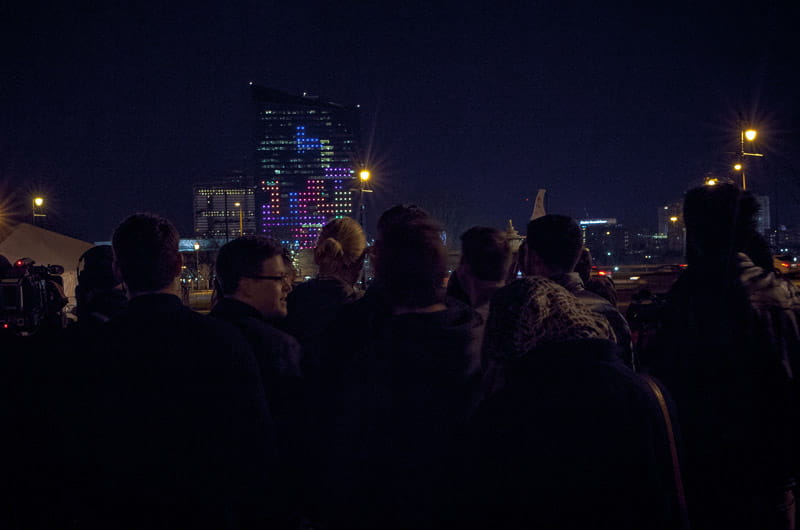由中学生创作的视频游戏将在Cira中心摩天大楼的LED阵列上播放,以开放新公园,德雷克塞尔广场

As part of an educational outreach program by Drexel's Entrepreneurial Game Studio, dozens of area middle school students designed and coded their own video games that will be played using the LED array on the 29-story Cira Centre skyscraper as part of opening festivities for Drexel Square park. (Photo courtesy of Aidan Un)
今年夏天,Brandywine Realty Trust的Cira Centre办公大楼的29层LED阵列将再次被改造成世界上最大的视频游戏显示屏,当地学生的创造力将得到充分展示。 来自大费城地区K-12学校的学生和老师一直在与德雷塞尔大学创业游戏工作室的专家合作,为这座建筑设计和编写新游戏——这些游戏将于6月10日晚首次亮相,作为该市最新绿地德雷塞尔广场开放庆祝活动的一部分。 Drexel广场公园的开放标志着Schuylkill Yards开发项目的第一个完成,这是大学城一个14英亩的总体规划社区,由Brandywine Realty Trust在Drexel拥有并与Drexel合作的土地上开发。
Festivities, which are free and open to the public, will begin at 6 p.m. at the newly opened Drexel Square park, on the northwest corner of 30th and Market Streets, with music, food trucks and games for people of all ages. The highlight of the night, an opportunity to play video games on a display created by the LED array of Brandywine Realty Trust’s Cira Centre, will begin at 8:30 p.m. Everyone in attendance will be eligible to enter a free drawing for a chance to play the games.
The games, which range from revamped versions of classic arcade games, like Pac-Man and Space Invaders, to original concepts, were created over the last year by students from schools across the region — The Benjamin B. Comegys School, The Baldwin School, Upper Merion Area Middle School, Russell Byers Charter and the Bucks County Chapter of Girls Who Code — as part of an outreach collaboration led by the Entrepreneurial Game Studio and its founding director Frank Lee, PhD, professor of digital media in Westphal College of Media Arts & Design.
Lee is the visionary behind towering displays of Pong and Tetris on the Cira Centre that set a Guinness World Record in 2014 for being the largest architectural video game display. This time around, Lee wanted to share the fun of giant video game-creation with Philadelphia-area students and their teachers.
“This is such an exciting opportunity, that we’re lucky to have right here in our neighborhood thanks to our partners Brandywine Realty Trust and Intel,” Lee said. “I had a great time seeing people play Pong and Tetris, but I thought it would be even better to come up with completely new games for the building — and what better way to do it than by tapping into the imagination of students right here in Philadelphia?”
To do it, the EGS, which is Drexel’s student game design incubator, with the support of Intel, hosted a series of design workshops for local middle school students at Drexel’s ExCITe Center where they worked in groups to conceptualize games that could be played on the LED display of the Cira Centre.
“A project of this magnitude takes time, and Intel was proud to be part of it from the early stages,” said Lee Machen, Intel’s director of consumer software. “Seeing these students achieve such an exciting goal — and make some wonderfully fun games — is truly a win for everyone involved.”
Through the workshops and continued outreach to local schools, the EGS identified five partner schools for the project.

Teachers at each school worked with Matthew Duvall, PhD, who was a postdoctoral research associate at EGS at the time, to learn Python, the coding language used to build the games. Teachers participated in regular training workshops over the course of several months to learn the program before working with their students to translate their concepts into computer code.
“P
The EGS group developed a web-based Cira Centre game simulator and a set of educational videos for the teachers to use in the classroom. And over the course of the school year each of the five school groups set about building their “skyscraper games.”
“This was a great project because there were so many ways for students to contribute, regardless of their prior with coding,” Duvall said. “Some students liked to focus on the visual aspects, others on the game design and the rules, while others enjoyed the coding. But it’s a big enough project that everyone can contribute to the end product. And it’s a nice way to introduce the concepts of computational thinking, game design and programming while working toward a very cool end goal.”
After working on the games throughout the school year, all of the groups presented their projects at a showcase event at Drexel’s ExCITe Center. Students had the opportunity to play each other’s games and explain how they created their own. In the culmination of the event, Lee announced that the students would actually get to play their games on the Cira Centre.
“It was a unique experience to see the kids from these different schools, with very different backgrounds, interact at the showcase and share their games with each other,” said Christian Johnson, at teacher at Upper Merion Area School District whose students participated in the project. “The students were so excited to see how other teams had accomplished the same goal they’d been working toward and to ask them questions about how they did it. The students were also very excited to find out that they will actually get a chance to play their games on the Cira Centre.”
In addition to the students and teachers stepping up to the controls, people in attendance can enter a drawing for a chance to play the games.
The games that will be featured at the June 10 event are:
- “Fill” – designed by students at Benjamin B. Comegys School
- “Falling” – designed by students at The Baldwin School
- “Dot Man” – designed by students at Upper Merion Area Middle School
- “Invasion of the Dots” – designed by students at Upper Merion Area Middle School
- “Caterpede” – designed by students at Upper Merion Area Middle School
For the students and teachers, this will be the first time they’ll see more than a year’s worth of work come to fruition — on a scale big enough for the city to see.
“The kids came into this as blank slates, with no experience in programming — and I only had a couple more months of experience on them. But we were determined to make this work, so we found the time after school and during free periods and pulled some resources together to make it happen,” said John Robertson, a teacher at Benjamin B. Comegys, a public school in Philadelphia, whose students’ game “Fill” was recognized at the showcase event. “A lot of people think coding is some mystical thing that only Mark Zuckerberg can do, but with some coaxing and this big end goal in sight they really became curious about it and took to the learning. I know they’ll be excited to actually play the game on the building, but I’m excited that they now have an important skill and the confidence to take on new learning challenges they think might be too big for them at first.”
Lee hopes to expand the opportunity to students across the country in the coming years as a way of inspiring creative thinking and helping schools to work more coding and programming into their curriculums.
“I think this is a fun way to introduce coding and scientific problem-solving to students,” Lee said. “When you have a beautiful piece of visual art, on a scale of this magnitude, as the end goal, it gives students the motivation to learn the new skills necessary and it also sparks their imagination to keep them interested and engaged in the project.”
Drexel News is produced by
University Marketing and Communications.
